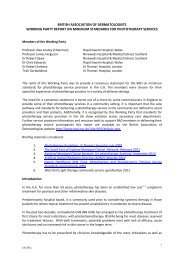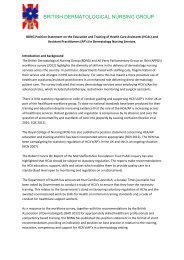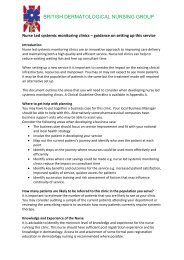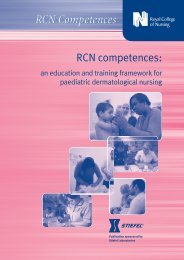Improving outcomes for people with skin tumours including melanoma
Improving outcomes for people with skin tumours including melanoma
Improving outcomes for people with skin tumours including melanoma
Create successful ePaper yourself
Turn your PDF publications into a flip-book with our unique Google optimized e-Paper software.
SSMDT meetings should be at least <strong>for</strong>tnightly. The key roles of<br />
the SSMDT over and above that of an LSMDT are to:<br />
• Provide a rapid diagnostic and treatment service (ideally at the<br />
same clinical session) <strong>for</strong> patients referred from LSMDTs.<br />
<strong>Improving</strong> Outcomes <strong>for</strong><br />
People <strong>with</strong> Skin Tumours<br />
<strong>including</strong> Melanoma<br />
Organisation of <strong>skin</strong><br />
cancer services<br />
• Provide specialist investigations and treatments not available to<br />
LSMDTs.<br />
• Undertake research <strong>including</strong> entering patients into NCRN- and<br />
WCTN-approved clinical trials. Wherever possible patients<br />
should be considered <strong>for</strong> clinical trials (e.g. adjuvant therapies or<br />
surgical treatments). Where trials are adopted <strong>for</strong> surgical<br />
procedures on lymph nodes, these patients should be referred<br />
and coordinated by the SSMDT.<br />
• Collect data <strong>for</strong> network-wide audit (Table 3).<br />
• Play a lead role in Mohs surgery activity <strong>with</strong>in the cancer<br />
network.<br />
3<br />
• Play a lead role in training and teaching health professionals<br />
about <strong>skin</strong> cancer.<br />
The SSMDT should have access to ITU or high-dependency facilities<br />
<strong>for</strong> major surgical cases (<strong>for</strong> example, widespread <strong>tumours</strong> affecting<br />
the head and neck). It should maintain close contact <strong>with</strong> other<br />
professionals who may be involved in supporting patients or carrying<br />
out the management strategy decided by the team, so that rapid<br />
access to their services can be provided when required.<br />
All cases referred to the SSMDT should receive <strong>for</strong>mal diagnostic<br />
histopathological review. There may be a few exceptions; <strong>for</strong><br />
example, cases referred <strong>with</strong> extensive BCC <strong>for</strong> surgical<br />
reconstruction. All cases requiring a tertiary histopathological opinion<br />
should be supported by the SSMDT on a commissioning basis.<br />
Patients reviewed by the SSMDT should be seen by and referred from<br />
the LSMDT in most instances, unless the SSMDT is also the LSMDT.<br />
However, in order to avoid undue delays some patients may be<br />
referred directly from doctors working in the community.<br />
Guidance on cancer services: <strong>skin</strong> <strong>tumours</strong> <strong>including</strong> <strong>melanoma</strong><br />
57















